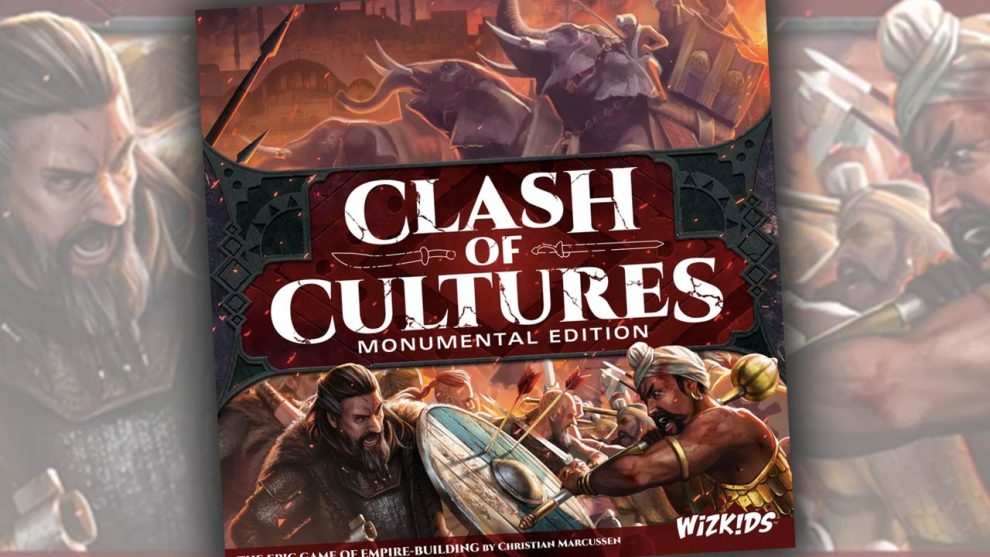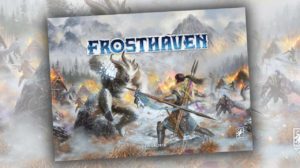Disclosure: Meeple Mountain received a free copy of this product in exchange for an honest, unbiased review. This review is not intended to be an endorsement.
Clash of Cultures: Monumental Edition is a large-scale 4X civilization building game for 2-4 players that will generally take around 3-4 hours to play. As a quick refresher: the four (e)X’s are explore, expand, exploit, exterminate.
In Clash of Cultures, you will be doing all of these x’s during the course of the game. Starting with one lowly settlement and one lonely settler, you’ll be exploring the randomly set up world via flipping over face-down tiles, expanding your empire by building new settlements, exploiting the lands through collecting resources, and exterminating the other players through dice-driven combat.
The World of Clashing:
Clash of Cultures has a predefined board shape setup based on the number of players, but all of the tiles are random and face-down except for your starting tile,.The multi-hex shapes of the land tiles allow both interesting configurations and relatively equal starting positions. Despite its significant table presence, the map in Clash of Cultures is pretty small for such a large-scale civ game. Personally, I like this aspect because it quickly forces player interaction.
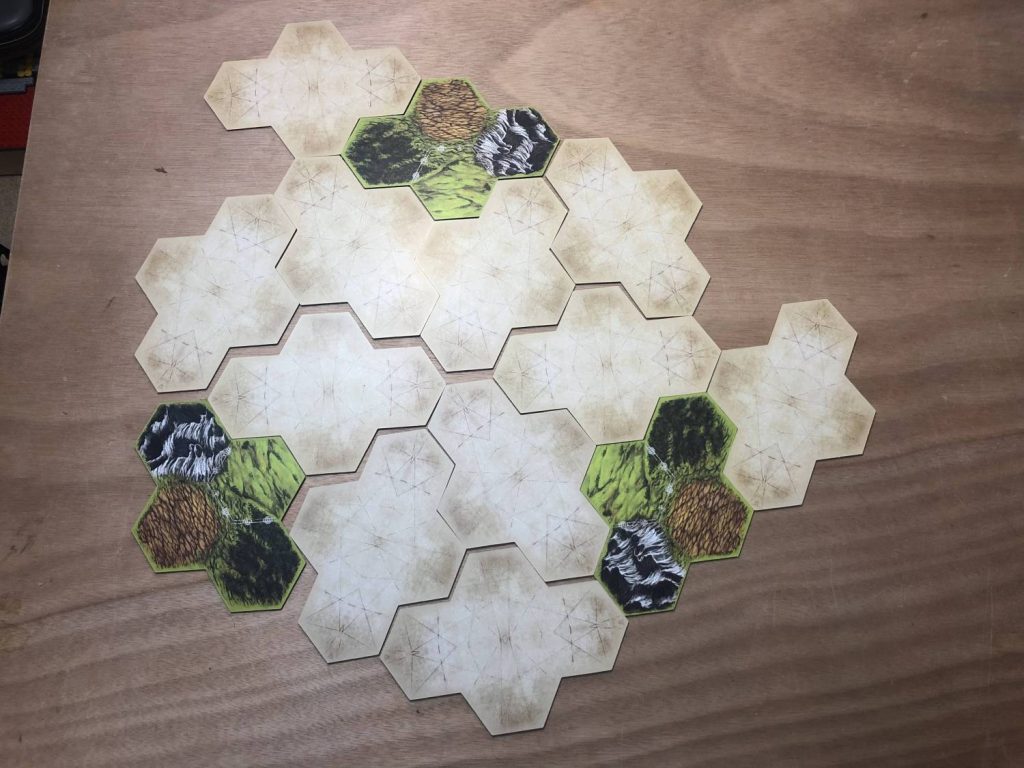
The Clash of Cultures: Monumental Edition also includes some expansion content, which you can opt to play with or without. The rulebook does a great job of highlighting the expansion content. If playing with the expansion, each player will also get a random Civilization board with three leader cards. In addition to taking all of their respective plastics (various unit and building miniatures), each player starts with two basic Advances on their Technology board, and sets their food level to 2. Put your one settlement and lone settler on the lush plains of your starting tile and you’re ready to clash.
Game Overview:
Clash of Cultures takes place over the course of 6 Ages, divided into 3 Rounds. After every 3rd round is a Status Phase. The game ends at the end of the 6th Age, or when any player has no cities on the board when entering the Status phase. Players who opt to conquer the world through military might don’t need to kill all their opponents to emerge victorious, only one of them. Victory through destruction is not guaranteed, as the ultimate winner is the one with the most Victory Points.
How to Play:
Clash of Cultures has a lot going on with a number of interlocking mechanics. Managing an entire civilization is no simple feat, after all. I won’t go into every detail, only the ones I believe necessary to understand the basic gameplay and give context to my final thoughts. Before we talk about what to do on your turn, we need to go over some foundational concepts integral to gameplay.
Resources:
There are 5 types of resources in the game:
Food: used to buy Advances (more on Advances later)
Ore: Used for construction, generally more for units
Wood: Used for construction, generally more for buildings and Wonders
Ideas: Can be substituted for food when buying Advances
Gold: Wild resource that can be used for anything.
All of these resources are managed by a token track on your individual player board. This is a great alternative to having dozens of individual resource tokens, as you’ll be frequently gaining and spending those resources.
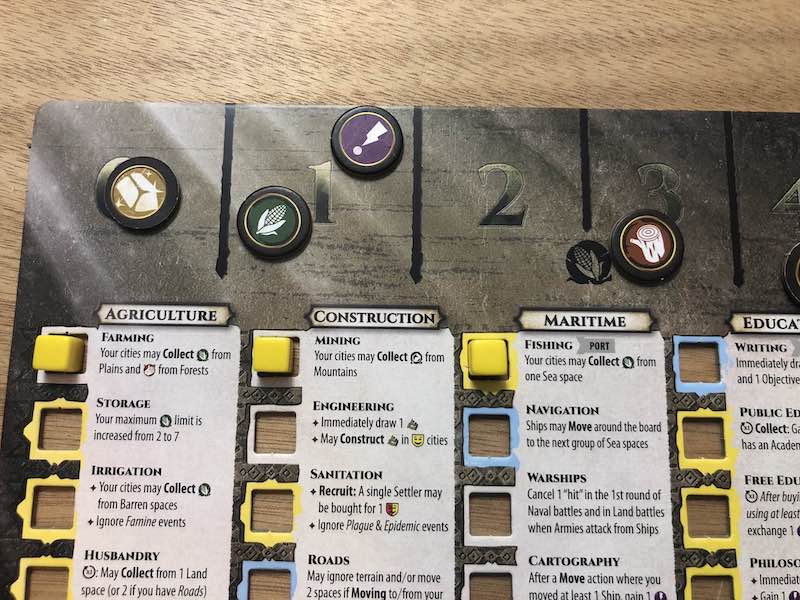
Mood:
Another element of your empire you’ll have to manage is your cities’ moods. Each city can either be Happy, Neutral, or Angry. Mood state will play a part in a number of game mechanics, but for the sake of brevity, I won’t get too into the particulars. Just try to keep your cities as happy as possible.

Advances:
The Advance system is Clash of Cultures’ version of a technology tree. Although it’s less of a tree per se–more like a freeform bush. Advances are also tracked on your individual player board. Each player starts with two basic advances: Farming and Mining. From there they are free to develop whatever advance they would like, with a couple of caveats. The board is divided into 12 subsections, each with four technological advances. In order to obtain an advance in any particular column, you must have obtained the topmost advance in that section. Thematically, this makes sense. You can’t learn Astronomy until you’ve understood Math.
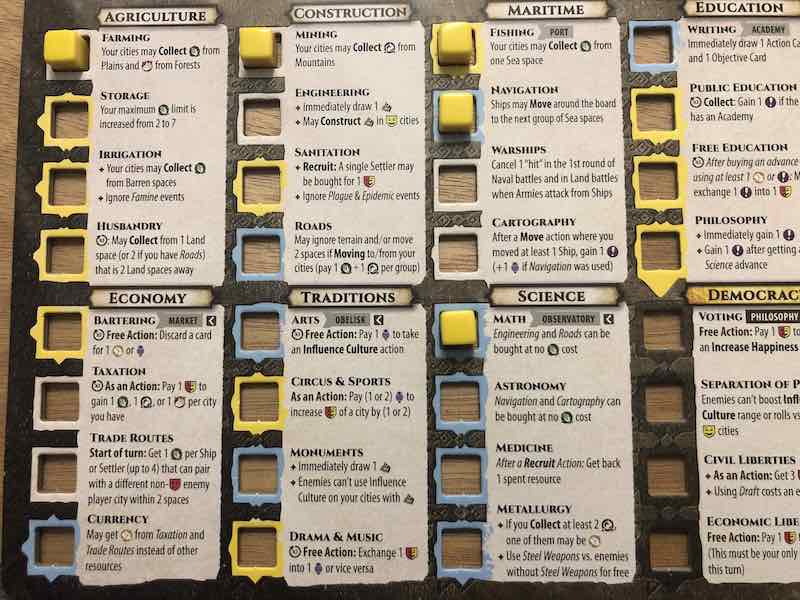
Additionally, the three bottom-right sections represent governments that you cannot develop until gaining the advance in the column directly above it, denoted by the down arrow. No Theocracy without a State Religion; no Democracy without Philosophy, etc.
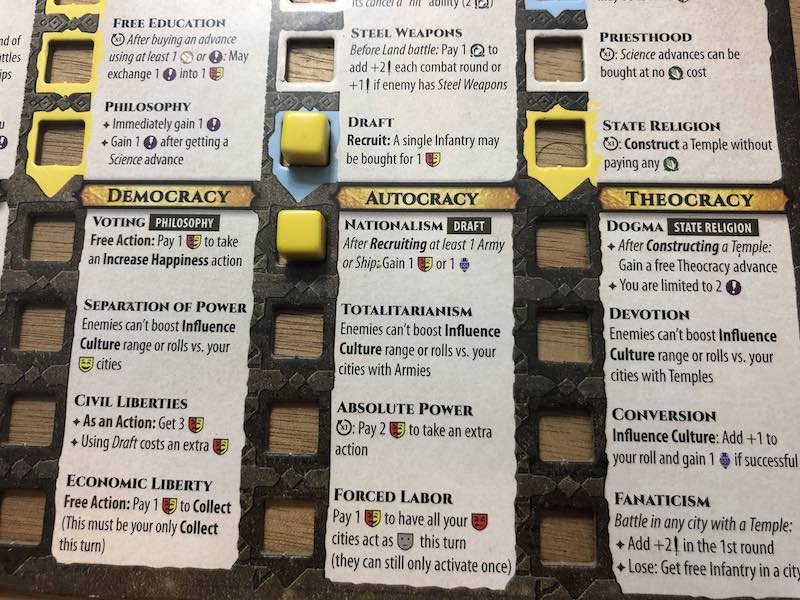
Player Turns:
On your turn you must perform 3 actions. The 6 standard actions are:
Advance: spend 2 food to buy a new advance
Found city: Replace one of your settlers from the board with a new settlement.
Activate an existing city: Perform one of the following
Recruit Units: spend resources to get more plastic people
Construct Buildings: spend resources to get more plastic buildings
Collect Resources: get more resources to spend later on advances or plastic pieces
Move Units: Move up to 3 groups of units 1 space.
Influence Culture: Attempt to change one of your opponents’ buildings into yours via dice roll
Increase Happiness: Spend mood tokens to change the mood of one of your cities.
After each player takes their three actions, you’ll move onto the next round. After three rounds you’ll do a status phase where you can draw and complete objective cards, get a free tech boost, and various additional actions that I don’t really need to get into at this point. After 6 ages, (18 total rounds) or if any player has been wiped out when you hit the status phase, the game ends. Count up your settlements, buildings, advances, completed objectives, and a few points sources that I didn’t mention, each of which give you a certain amount of VP’s. Highest VP total wins.
There are a lot more rules, concepts, and nuances in Clash of Cultures that I could dig deeper into like city size, tile placement restrictions, wonders, barbarians, and event cards. I haven’t even mentioned the combat system. (Rapid summary: dice-based, with potential special abilities based on unit type, affected by playing cards and gaining particular advances.)

All of that is ultimately not necessary to understand the basic concept of the game or provide an adequate background and context to my thoughts about the game.
Final Thoughts:
Clash of Cultures: Monumental Edition lives up to its name. The game is indeed as large as…a large monument. The production level is fantastic. It’s clear that great care has been given into every element of the game aesthetic. The graphic design is clear, the player boards are intuitive, the expansion content is clearly denoted, and aside from a few droopy spears here and there, the miniatures are fantastic.
Clash of Cultures is massive in its scope, primarily when it comes to Advances. While I do love tech trees and their subsequent development of player power asymmetry, therein is where I feel Clash of Cultures may get a little too big for its plastic britches. Getting a new Advance is a relatively easy proposition. It’s highly possible for you to get new technology every turn. While that prospect initially sounds cool, my inner monologue of “Ooh! Look at all this cool new stuff I’m getting” quickly turned into “Oof! Look at all this stuff I have to remember.”

Such and such gives me this power, which lets me construct “x” building, which lets me build “y” units. Those units get me “z” ability in combat if I roll them, but my opponent played “such and such” card, which does this other thing, etc. The internal flowchart from decision to result flows about as well as molasses through a brick.
One of my favorite games is Through the Ages, which also simulates building civilizations albeit through very different mechanisms. Like Clash of Cultures, it also has elements of resource management, technology advances, and military strength. However, Through the Ages never feels like it’s overwrought, even with its significantly fiddly bookkeeping. Clash of Cultures can at times feel like a chore keeping up with who has which abilities, when and how they work. With the expansion content, it’s even more complicated. Your civilization has a special ability; you can recruit a leader which has a special ability. If that leader dies, you have two more leaders to pick from, each with their own special ability. Thing is, I don’t want to play without the expansion content because I like a lot of what it brings in, particularly the new types of buildings and units.

I do enjoy Clash of Cultures. The production for the Monumental edition is fantastic, the gameplay is engaging, and it provides a sufficient amount of epic experience and emerging narrative that I tend to relish in my game sessions. It is the closest a board game has come to simulating PC games like Sid Meier’s Civilization, Alpha Centauri, or Total War, but I sometimes forget how much of the finer details in those games are handled by the internal game engine. Clash of Cultures can feel bloated at times because handling that much information at one time is a weighty proposition
Ultimately, Clash of Cultures does some really good things, but sometimes too much of a good thing is no longer a good thing. Putting hot fudge on your ice cream sundae is wonderful. Adding so much hot fudge that the ice cream becomes but a distant memory of a vanilla bean is hard to stomach, unless I’m specifically in the mood for a hot fudge dessert soup.
I still enjoy it well enough to keep it in my collection and bring it out to play every now and then, but it’s not going to take precedence over Through the Ages or even Twilight Imperium: 4th Edition if time isn’t a limiting factor. I hesitate to recommend it unless you know you’re willing to bog through the bloat in order to dig out the diamonds. 7/10 for me.


